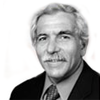INNOVATIVE TEACHING SHOWCASE
Fostering Leadership among Student Leaders
by Joseph E. Garcia, Karen W. Morse Institute for Leadership
Overview
The call for leadership education has been and continues to be strong as faculty and students today recognize the career ladder of old is no longer viable and that graduates need critical skills in cultural competencies, ethical decision making, strategic thinking, emotionally-intelligent self-management, and interpersonal skills in order to address an ever-changing, complex, and nuanced world.
 Unfortunately, for many students, leadership is something that people in “high”
positions have and is generally unobtainable unless they have been selected to be
“in charge.” For many academics, leadership is something that lacks academic rigor
and is marketed from the perspective of a successful individual who writes about
his or her (his more often) personal experience and success.
Unfortunately, for many students, leadership is something that people in “high”
positions have and is generally unobtainable unless they have been selected to be
“in charge.” For many academics, leadership is something that lacks academic rigor
and is marketed from the perspective of a successful individual who writes about
his or her (his more often) personal experience and success.
The challenge in Leadership Studies is to shake these misperceptions and ensure
that leadership is understood in a much broader and accessible context. Scholarship
in the social sciences, education, and management today shows that leadership is
embedded in the “relationship” between an individual and others such that the individual
is empowered to guide the group to achieve some objective that reflects mutually
shared goals. To be blunt, leadership is not about a
position, or a formal title. It is about the connections between people, individuals
who may be called leaders and followers. Through these connections, individuals,
groups, organizations, and societies are able find their way towards achieving their
dreams.
 In my view, this orientation towards leadership is captured by the words of the
Chinese philosopher Lao-tzu some 2500 years ago when he said, “Go to the people.
Learn from them. Live with them. Start with what they know. Build with what they
have. The best of leaders when the job is done, when the task is accomplished, the
people will say we have done it ourselves.”
In my view, this orientation towards leadership is captured by the words of the
Chinese philosopher Lao-tzu some 2500 years ago when he said, “Go to the people.
Learn from them. Live with them. Start with what they know. Build with what they
have. The best of leaders when the job is done, when the task is accomplished, the
people will say we have done it ourselves.”
Helping students understand leadership from this perspective includes and goes beyond talking about leadership theory and skills. Providing students opportunities to engage in the leadership experience, with conceptual frameworks to scaffold their experience makes the learning real. So in addition to providing information on findings of social science research on leadership, students are asked to link their personal leadership experiences to conceptual models and the experience of practicing professionals.
Courses and Their Structures
Leadership Studies (LDST) 101 and 450 are two courses in Leadership offered through the

In Leadership Studies 101, we have a structure to support such an integrated approach to learning using peer leaders. The structure includes the following:
- A large class lecture component.
- Traditional coverage of formal course content in a lecture format.
- Six sessions where guest speakers who are working professionals at differing levels (e.g., senior executive, first line supervision, leading volunteers) come to class to share their experiences and respond to student-generated questions in an interview format with the professor.
- Weekly small group discussion session co-led by two more experienced peers, who are enrolled in LDST 450, where students engage in leadership exercises; as well as prepare, reflect upon, and process their conversations on leadership with working professionals.
- An internet-supported assignment where each student is required to lead a conversation with a professional on topics from the lecture and the text for purposes of comparing formal theory and research on leadership with the experience of working professionals.
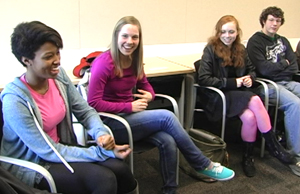
This experience impacts the LDST 450 student as well as the LDST 101 student. For the LDST 101 student, they experience the large class as a more friendly and supportive learning
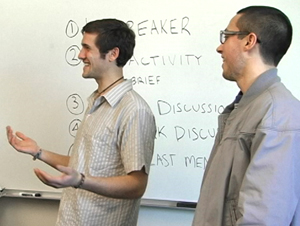
The peer leadership relationship is a Petri-dish for leadership development for both groups of students: the LDST 101 students rate the discussion sessions as having a positive impact on their lives that goes beyond the formal course materials and the LDST 450 students report learning more about the importance of the so called “soft” skills associated with leadership that will make a difference for them as they move from college into their professional lives.
A Leadership Learning Model
The overall design of the curriculum is based on the notion that there is an accumulated body of knowledge about leadership and leadership inquiry that is the core learning material for the course. Surrounding this core are the professor, the LDST 101 students, the LDST 450 students and the professionals who engage with the students, and the learning material from these different perspectives. The professor is a subject matter expert, the students are novice learners at different levels, and the professionals have practical experience that in their respective roles facilitate learning about leadership theory and practice, as diagramed here:
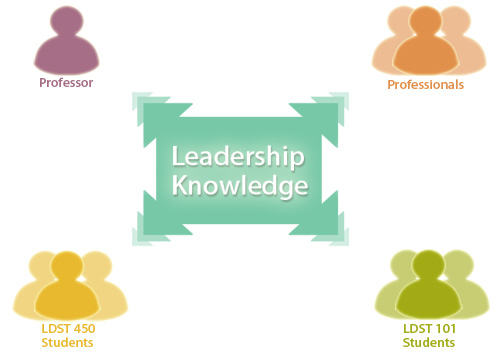
Respecting each party’s role, subject matter expertise, and experience, the course is organized as a mutual learning environment with each member contributing to each other’s learning. For example, evaluations of the course by the LDST 101 students indicate that they benefit greatly from their student discussion session leaders and guest professionals. The LDST 450 students also indicated that the experience of leading their discussion sessions was a powerful learning experience as well as interacting with professionals who brought their experience and practical wisdom to their learning. A survey of professionals who participated in the course indicated that their involvement with their student was a satisfying experience. And from a professor’s perspective, viewing the interactions between professionals and students has given me information on how to improve the curriculum for next year and stimulated ideas for research on teaching and learning.
Logistics and Other Challenges
While well worth the effort, these courses are a complex undertaking and to sing praises of the course without acknowledging its challenges is inappropriate. In the next few paragraphs I will briefly highlight four logistical challenges and one student-related challenge so as to identify areas of concern.
 First of all, as with any large lecture class, advanced planning and organization
are critical. Fortunately, web based tools such as Blackboard (or other learning
management systems) are useful for managing communication of assignments, notices
of events and responses to student questions outside of class hours that might otherwise
disrupt the flow and schedule of the course. However, this is just the tip of the
proverbial iceberg.
First of all, as with any large lecture class, advanced planning and organization
are critical. Fortunately, web based tools such as Blackboard (or other learning
management systems) are useful for managing communication of assignments, notices
of events and responses to student questions outside of class hours that might otherwise
disrupt the flow and schedule of the course. However, this is just the tip of the
proverbial iceberg.
Second, connecting the LDST 450 students to their LDST 101 discussion session needs to be completed before the term begins so as to have each discussion session staffed with two discussion leaders. Additionally, prior to the first class session the 450 students benefit from a special three-hour class orientation session to prepare them for their first sessions as co-leaders of their discussion sessions.
Third, contacting and scheduling guest professionals for classroom visits requires special effort and long lead times. By partnering with the Office of University Advancement we were able to obtain a slate of high profile leaders to spend a day on campus, interact with both classes, and meet with faculty and staff who share common interests.
The fourth and perhaps the largest issue is the management and assignment of the professionals to their students. The course utilized 112 professionals from around the world, including China, Slovenia, and Mexico and throughout the United States. All communication with the professionals was made though email to provide orientation materials, the course outline, and schedule for the term. Using an online collaboration platform each professional was matched to a student enrolled in the course. This was facilitated by Ms. Wendy Knight, who developed an effective system for signing on and matching the professional and student.
A more vexing issue was with students who were not prepared to invest in the special opportunities this course offered. Although the majority of the students took advantage of the course offering, ten to fifteen did not authentically engage with their professional or the discussion session. While some lack of student engagement is not an uncommon occurrence in courses, this course is highly visible to an external audience who expects students to step up to challenges. Personally, I am not as concerned with what the external audience thinks of me, as much as how the relative inaction of a few students (i.e., 10-15 out of 112) impact impressions of Western students in general. Anticipating this possibility, I warn the professionals that the students in the class are predominantly first-year students, and some of them are still finding their way, and this class may not be where they place their priorities. Hopefully, this message mitigates any potential negative impacts generated by those less engaged students.
What Next
These two courses have generated positive results beyond the immediate course outcomes. These include:
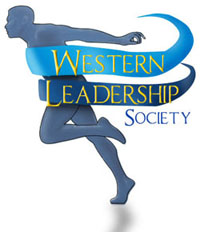
- A new Associated Students club, Western Leadership Society, has been created by former students in these classes.
- Students from LDST 450 have given presentations at Western’s Scholars’ Week and the Alumni Offices’ Back 2 Bellingham event for alumni and friends of Western.
- Course enrollment is strong.
- Professionals want to be involved by participating in the classes.
Given these results, the courses will continue to be offered, improved upon, and hopefully made available to more students.
Some of the lessons learned from this course include the following:
- Students in large classes can benefit greatly from the use of instructional assistants or discussion session leaders when these peer leaders are provided guided instruction on their leadership responsibilities and development. This is true both in terms of course management and in terms of student satisfaction with the course.
- Using professionals from the community to interact with students in a structured form with course content guiding that relationship reinforces learning and engagement. Furthermore, when given clear guidelines these volunteers contribute to the class significantly and want to give more.
- The LDST 101 experience described here can be modified to smaller upper division classes with far fewer logistical issues. Both the size (112 students) and level (mostly first-year students) opened the door to more confusion and complications than would be the case with a class of 35 seniors who are more focused and experienced as college students.
- Finding professionals to interact with students is easier that it might seem. There are many professionals who want to give back and offices such as the Alumni Association and University Advancement can be quite helpful.
- The learning model is helpful in guiding decisions about curriculum development and delivery. As structured, it keeps knowledge, in the broadest sense, at the core of the process and the people, professor, students, and professionals as members of a learning community who engage in dialog about the course content.
Sources
Daft, R. L. (2011). The Leadership Experience (Fifth ed.). Mason, Ohio, USA: South-Western Cengage Learning.
Greenwald, R. (2010, December 5). Today's Students Need Leadership Training Like Never Before. Chronicle of Higher Education. Retrieved March 13, 2012, from http://chronicle.com/article/Todays-Students-Need/125604/
Acknowledgements
I would like to acknowledge the following individuals who helped develop my thinking and/or were instrumental in the implementation of these courses as well as the students and professionals who participated in this experiment in learning: Mr. Ramiro Espinoza, Ms. Anna Griebel, Professor Jennifer Hays, Ms. Wendy Knight, Professor Robert Marx, Mr. Ryan Scott, Mr. Art Stavig, and Professor Kristi Lewis Tyran.

